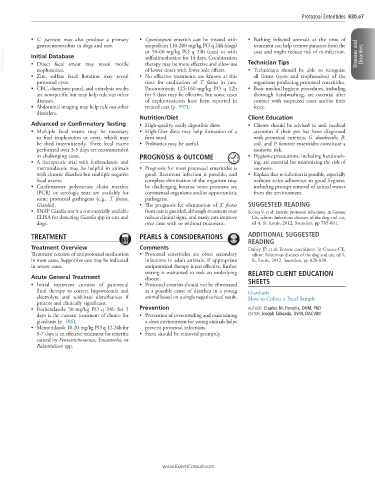Page 1654 - Cote clinical veterinary advisor dogs and cats 4th
P. 1654
Protozoal Enteritides 830.e7
• C. parvum may also produce a primary • Cystoisospora enteritis can be treated with • Bathing infected animals at the time of
gastroenterocolitis in dogs and cats. amprolium 110-200 mg/kg PO q 24h (dogs) treatment can help remove parasites from the
VetBooks.ir Initial Database sulfadimethoxine for 14 days. Combination Technician Tips Diseases and Disorders
coat and might reduce risk of re-infection.
or 50-60 mg/kg PO q 24h (cats) or with
therapy may be more effective and allow use
• Direct fecal smear may reveal motile
of lower doses with fewer side effects.
trophozoites.
• Zinc sulfate fecal flotation may reveal • No effective treatments are known at this • Technicians should be able to recognize
all forms (cysts and trophozoites) of the
protozoal cysts. time for eradication of T. foetus in cats. organisms producing protozoal enteritides.
• CBC, chemistry panel, and urinalysis results Paromomycin 125-160 mg/kg PO q 12h • Basic medical hygiene procedures, including
are nonspecific but may help rule out other for 5 days may be effective, but some cases thorough handwashing, are essential after
diseases. of nephrotoxicosis have been reported in contact with suspected cases and/or their
• Abdominal imaging may help rule out other treated cats (p. 997). feces.
disorders.
Nutrition/Diet Client Education
Advanced or Confirmatory Testing • High-quality, easily digestible diets • Clients should be advised to seek medical
• Multiple fecal exams may be necessary • High-fiber diets may help formation of a attention if their pet has been diagnosed
to find trophozoites or cysts, which may firm stool. with protozoal enteritis; G. duodenalis, B.
be shed intermittently. Three fecal exams • Probiotics may be useful. coli, and P. hominis enteritides constitute a
performed over 3-5 days are recommended zoonotic risk.
in challenging cases. PROGNOSIS & OUTCOME • Hygienic precautions, including handwash-
• A therapeutic trial with fenbendazole and ing, are essential for minimizing the risk of
metronidazole may be helpful in animals • Prognosis for most protozoal enteritides is zoonosis.
with chronic diarrhea but multiple negative good. Recurrent infection is possible, and • Explain that re-infection is possible, especially
fecal exams. complete elimination of the organism may without strict adherence to good hygiene,
• Confirmatory polymerase chain reaction be challenging because some protozoa are including prompt removal of animal wastes
(PCR) or serologic tests are available for commensal organisms and/or opportunistic from the environment.
some protozoal pathogens (e.g., T. foetus, pathogens.
Giardia). • The prognosis for elimination of T. foetus SUGGESTED READING
• SNAP Giardia test is a commercially available from cats is guarded, although treatment may Scorza V, et al: Enteric protozoal infections. In Greene
ELISA for detecting Giardia spp in cats and reduce clinical signs, and many cats improve CE, editor: Infectious diseases of the dog and cat,
dogs. over time with or without treatment. ed 4, St. Louis, 2012, Saunders, pp 785-801.
TREATMENT PEARLS & CONSIDERATIONS ADDITIONAL SUGGESTED
READING
Treatment Overview Comments Dubey JP, et al: Enteric coccidiosis. In Greene CE,
Treatment consists of antiprotozoal medication • Protozoal enteritides are often secondary editor: Infectious diseases of the dog and cat, ed 4,
in most cases. Supportive care may be indicated infections in adult animals. If appropriate St. Louis, 2012, Saunders, pp 828-839.
in severe cases. antiprotozoal therapy is not effective, further
testing is warranted to seek an underlying RELATED CLIENT EDUCATION
Acute General Treatment disease.
• Initial treatment consists of parenteral • Protozoal enteritis should not be eliminated SHEETS
fluid therapy to correct hypovolemia and as a possible cause of diarrhea in a young Giardiasis
electrolyte and acid-base disturbances if animal based on a single negative fecal result. How to Collect a Fecal Sample
present and clinically significant.
• Fenbendazole 50 mg/kg PO q 24h for 5 Prevention AUTHOR: Charles M. Hendrix, DVM, PhD
days is the current treatment of choice for • Prevention of overcrowding and maintaining EDITOR: Joseph Taboada, DVM, DACVIM
giardiasis (p. 386). a clean environment for young animals helps
• Metronidazole 10-20 mg/kg PO q 12-24h for prevent protozoal infections.
5-7 days is an effective treatment for enteritis • Feces should be removed promptly.
caused by Pentatrichomonas, Entamoeba, or
Balantidium spp.
www.ExpertConsult.com

